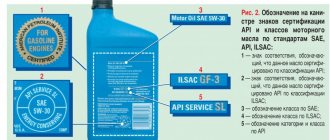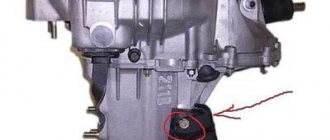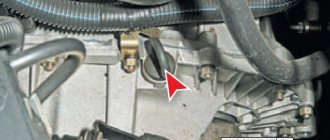How does the checkpoint work?
To understand why high-quality oil is the key to good gearbox performance, you need to understand what this unit does and how it works. The engine rotates the crankshaft at a fairly high speed, but with low torque, which is why the transfer of energy directly from the engine to the wheels is possible only at high speeds, where it is enough to maintain a given pace of movement. Therefore, it is necessary to reduce the crankshaft rotation speed while simultaneously increasing the torque. This is exactly what the gearbox does. Regardless of the type of gearbox, the principle of operation is always the same - a gearbox consisting of a large and small gear either reduces the shaft rotation speed, increasing torque, or, conversely, increases the rotation speed, reducing torque. At the same time, the power remains unchanged.
Gear shifting occurs due to a different combination of the drive and driven gears of the gearbox. In a manual (manual) transmission, the driver, using a lever that operates the fork system, connects the desired combination of gears. In an automatic transmission (automatic transmission), this process is controlled by various systems. In CVT gearboxes, there is no control system, and its function is performed by a drive gear or pulley, depending on the design of the unit.
When the gearbox converts rotation speed and torque, its gears come into close contact with each other, causing their teeth to wear out under the influence of friction. The oil almost completely eliminates friction, thereby reducing gear wear. When shifting gears, the forks activate the gears, moving them along the primary and secondary shafts, causing their teeth to mesh. High-quality oil facilitates gear shifting and lubricates and cools gears and bearings. In automatic transmissions, oil cools the electrical and mechanical components of the box, and is also often the working medium of the gear selection system. All this allows us to conclude that the oil should be:
- quality;
- corresponding gearbox for viscosity;
- corresponding gearboxes for maximum and minimum temperatures.
Capacity for filling oil into the rear axle gearbox of VAZ 2107
You won’t believe it, but there are also owners who don’t even know that the rear axle of a car also needs regular lubrication, although not as often as the engine. Also, there are drivers who believe that if the oil does not expel or ooze, there is no need to change it at all. This is all wrong and it is also necessary to perform this procedure, as in the internal combustion engine and in the gearbox.
The lubricant volume should be 1.3 liters. To fill the required level, you need to wait until the oil flows from the filler hole; this will be considered the optimal volume.
What kind of oil is poured into the gearbox - types of oil for different gearboxes
Automotive stores offer various types of oil - motor, transmission, hydraulic, and so on, but which one is suitable for a particular gearbox? You can use the help of a seller or manager, but with a 95% probability he will offer not the one that is best suited for a particular box, but the more expensive one. The choice of oil type depends on the following parameters:
- gearbox designs;
- loads on the box;
- power and engine speed.
For this reason, the manufacturer makes recommendations on what type and grade of oil is ideal for this unit. After all, boxes with straight gears require one type of oil, and boxes with oblique gears require another. For mechanics, one type of oil is required, for a hydraulically controlled gearbox another, and for a robotic gearbox a third. Cars with low-power engines require one oil, and cars with powerful engines require another. Therefore, the best way to determine the type and grade of oil is to follow the advice given in the vehicle's owner's manual. In most cases, this slightly increases the cost of servicing the car, because manufacturers recommend premium oil from their partners, but it is much cheaper than repairing a box that has broken down due to unsuitable oil.
About types of transmission oils
How long does it take to change brake fluid?
Today, two types of gear oils can be found on the fuel and lubricants market: GL-5 standard oil and GL-4 standard oil. Here are their differences:
- GL-4 standard. These are transmission oils used in gearboxes and drive axles with hypoid and bevel gears operating at moderate temperatures and loads;
- GL-5 standard. It includes transmission oils used in high-speed axles and gearboxes operating under conditions of high temperatures and alternating shock loads.
From the above, it becomes clear that the GL-5 standard provides better extreme pressure protection for the gears in the transmission. But this is a common misconception to which many car owners, including VAZ 2107 owners, are susceptible.
Let's take a closer look at this point.
Transmission oils of the GL-5 standard use special complexes of sulfur-phosphorus additives, which create an additional protective layer on the rubbing steel parts of the gearbox. But if such an additive comes into contact with parts containing copper or other soft metal, then the protective layer formed by the additive turns out to be stronger than the copper surface. As a result, wear on the soft metal surface accelerates several times.
Research shows that the use of GL-5 standard lubricant in gearboxes that require GL-4 standard lubricant is not only not advisable, but also dangerous.
For example, synchronizers in VAZ 2107 boxes are made of brass.
And with prolonged use of GL-5 oil, they will be the first to fail. It is for this reason that the owner of a VAZ 2107 should fill only GL-4 standard oil into the gearbox.
The second most important point that the owner of a VAZ 2107 should remember is the viscosity class of the oil being poured. Today there are two such classes:
- class SAE75W90. It includes semi-synthetic and synthetic transmission oils, which motorists call all-season. This lubricant works in a wide temperature range - from -40 to +35°C. It is this class of oils that is ideal for use in our country;
- class SAE75W85. The upper temperature limit for oils of this class is higher. But it should not exceed 45°C, since at this temperature the oil begins to boil.
Brand and volume of oil for gearbox VAZ 2107
There are several brands of GL-4 gear oil that are especially popular among VAZ 2107 owners. We list them:
The volume of oil poured directly depends on the number of gears in the car’s gearbox. If the VAZ 2107 is equipped with a four-speed gearbox, then it will require 1.4 liters of oil, and for a five-speed gearbox it will require 1.7 liters.
Replacement intervals - when to change the oil?
When to change the gearbox oil is the subject of debate on numerous forums. Some argue that the gearbox oil needs to be changed every 50 thousand kilometers, others say that every 100-200 thousand, and still others refer to the manual for some cars, where it is written that the oil is filled for the entire service life and does not require replacement . Manufacturers are interested in ensuring that the machine lasts the warranty period and becomes in such a condition that it would have to be repaired or replaced. Those who change oil every 200 thousand kilometers assume that the car will survive one oil change, but let the new owner think about another.
It is known from experience that the optimal mileage before an oil change with leisurely and careful driving on good roads, minimal vehicle load, a working engine and gearbox is 80–100 thousand kilometers. Driving on bad roads reduces the optimal mileage by 5–10 thousand kilometers. The love of speed, fast starts and aggressive driving reduces the optimal mileage by 10–20 thousand kilometers. Any malfunction of the gearbox or engine reduces the optimal mileage by 5–20 thousand kilometers. Frequent transportation of goods reduces the optimal mileage by 5–10 thousand kilometers.
All these rules apply to both manual and automatic transmissions. Therefore, the optimal mileage after which it is advisable to change the oil in the gearbox is 40–100 thousand kilometers, depending on the operating conditions of the car, the quality of the oil and the skill of the driver. In this case, the oil change must be made before the performance of the box deteriorates. Owners of cars with automatic transmissions often put off changing the oil until the transmission begins to malfunction. If this happens, it means that the oil that has processed its resource has already begun to negatively affect the condition of the unit.
It is necessary to understand that the worse the condition of the gearbox, the more often the oil needs to be changed. After all, the deterioration of the gearbox is associated with:
- loss of the cementing layer on gears and shafts;
- reducing the capacity of channels and jets;
- decreased lubricity of oil;
- jamming of forks and other moving elements.
What is the volume of the VAZ 2110 box
How long does it take to change engine oil?
In the proposed material we will determine exactly how much oil to pour into the VAZ box. The meticulousness of the question is justified, since the normal operation of the vehicle is at stake. Young drivers will learn how many liters of lubricant should be purchased for one-time filling into the gearbox crankcase.
The modifications of this car with different power units produced by the auto company are equipped with the same type of variable speed gearboxes with minimal technical correction. The designers are one hundred percent right here. Why reinvent another wheel when launching an updated old model into series. The unification of the transmission unit is justified from an economic point of view.
The unified unit initially requires an exact volume of oil in the box. So, how much oil is in the box of the popular VAZ 2110 - 3.5 liters. The lubricant is enough for a car to run 60 thousand kilometers. After which you should change the lubricant. It is necessary that the crankcase contains exactly this amount of lubricating consistency. That is 3.5 liters.
More is possible, but the reserve is detrimental to the car. Increased volume:
- quickly destroys numerous oil seals;
- negatively affects engine power;
- increases fuel consumption.
The negative will definitely appear if you add even 200 grams above the norm.
What happens if the oil is not changed on time?
Many drivers are confident that if they don’t change the oil in the gearbox on time, nothing bad will happen. In fact, even a slight delay in changing the oil not only worsens the performance of the gearbox, but also increases wear on parts. Because of this, metal shavings get into the oil, which clogs the oil filter (if one is installed). If there is no oil filter, then lubricant with metal dust and chips gets between the rubbing parts, increasing their wear. Because of this, the box begins to hum. If it comes to a hum, then the box doesn’t have long to work.
Perhaps it will work for another 30 or even 50 thousand after changing the oil, but parts with worn-out cementitious coating have much less strength and abrasion resistance. Therefore, after adding new oil, metal dust or chips will quickly appear in it. On automatic transmissions with hydraulic gear shifting, even a slight delay in changing the oil leads to deterioration of the hydraulic system, less clear gear shifting, and delays in operation. This happens due to clogging of the channels and jets, so changing the oil will not radically change anything. Therefore, after changing the oil, the condition of the box, if it improves, will be only slightly, and then will continue to deteriorate.
Choosing the right oil
Of course, the manufacturer recommends using domestic oils. There are many options available in the automotive market. It can be any company, the main thing is that the working fluid has the required viscosity and meets the quality class according to API/ACEA standards. AvtoVAZ recommends filling in 2114:
- VOLNEZ TM4.
- REXOL T.
- OMSKOIL TRANS P.
Of course, the gearbox oil should be “weather-appropriate”. For example, operating a car in winter with a liquid that is designed for above-zero temperatures will not only be harmful to the structure, but also dangerous. If in winter the VAZ 2114 can be started immediately after pressing the clutch pedal, then the oil was chosen correctly.
How much oil to pour into the gearbox or the dangers of underfilling and overfilling
Each type of gearbox has its own oil requirement. Therefore, it is impossible to say that there is so much in the Ford Focus, and so much in the Toyota Camry. After all, the volume of oil depends on the specific box. Therefore, it is necessary to strictly follow the recommendations contained in the repair and maintenance manual for the machine. What are the dangers of underfilling and overfilling oil? If the oil level is below normal, then when operating at high speeds, lubrication and cooling of the rubbing parts worsens, which increases their wear. If the oil level is much lower than normal, then this process begins at medium and sometimes at low engine speeds. In this case, at high speeds, the parts come into contact with almost no lubrication, which is why their service life is sharply reduced.
If the oil level is higher than normal, then while the car is moving in gear, the pressure on the seals is higher than the calculated one and pushes them through. As a result, oil begins to leak out of the gearbox onto the ground. Over time, this process intensifies, which leads to a significant decrease in the oil level and damage to the box. This process takes place equally on both obsolete Soviet mechanics and modern hydraulic or robotic automatic transmissions. The only difference is the cost of parts and repairs. Therefore, the volume of oil being poured, as well as its level (this is especially important when partially changing the oil in automatic transmissions) must fully comply with those specified in the repair and operating instructions for the machine.
Technical regulations on the amount of transmission substance
Transmission fluid is monitored every 10 thousand km, i.e. during the next maintenance. Before checking the amount of substance, you need to let the car sit for a while. During this period, the transmission fluid will have time to flow down the walls of the box. If the fluid level reaches the edge of the lower edge of the filler hole, then its volume is quite sufficient, and the oil is not replaced or topped up.
How much transmission oil will be needed when completely replacing it directly depends on the type of gearbox.
According to the technical instructions, the following volume of liquid is established:
- for 4-mortar – 1.35 l;
- for a 5-mortar – 1.6 l.
Experienced drivers advise filling the 5-mortar with lubricant slightly above the set level - “as much as it will fit.” To do this, lift the car from the driver's door with a jack. Then add 250–300 g of liquid. This will ensure reliable lubrication of the 5th gear gear. There is no need to be especially afraid of increased pressure on the seals, since excess pressure is released through the breather.
Table of volumes of several brands (how much to pour for a complete replacement)
Amount of oil in automatic transmission
(in liters, for complete replacement)
This is where I end, I think the article was useful to you. Read our AUTOBLOG.
(
11 votes, average: 4.45 out of 5)
Similar news
Transmissions are not included. Appears when the engine is running - os.
How much does it cost to change the oil in an automatic transmission? Detailed material.
A robotic gearbox is different from an automatic one. Cap.











